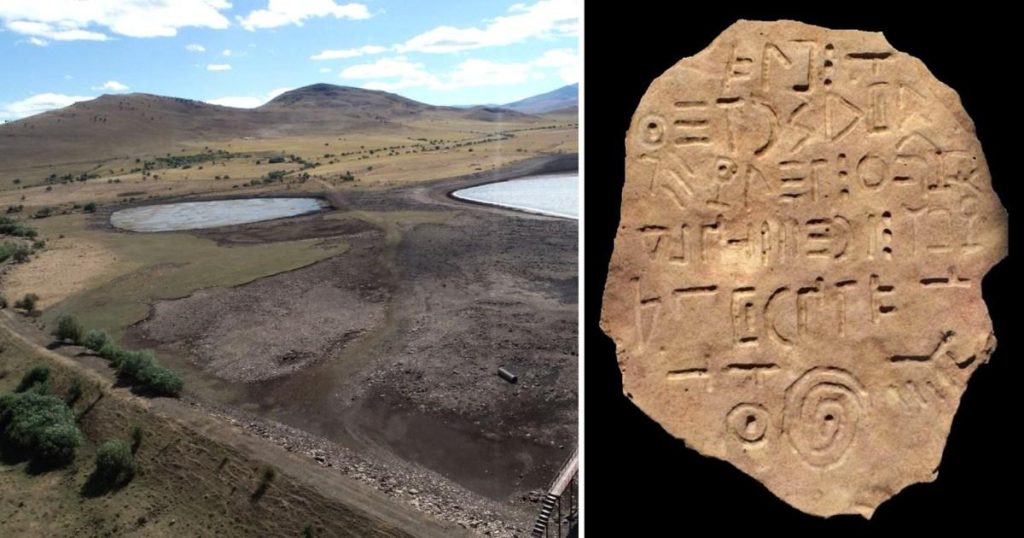A Riddle Etched in Stone: Unearthing a Lost Language in Georgia
The discovery of an ancient stone tablet near Bashplemi Lake in Georgia has ignited a firestorm of excitement and intrigue within the archaeological community. Unearthed in 2021, this book-sized basalt slab bears an intricate script that has defied decipherment, posing a tantalizing puzzle for experts worldwide. Initial analysis suggests the language etched upon its surface dates back to the Late Bronze Age, approximately 3,500 years ago, placing it within a period teeming with vibrant cultures and nascent writing systems across the Mediterranean world. The tablet’s resilience, carved into the notoriously hard basalt rock, hints at the inscription’s importance, possibly representing a significant event, a dedication to a deity, or a record of military achievements. The discovery offers a unique window into a lost world, promising to reshape our understanding of ancient communication and cultural exchange.
The inscription itself is a complex tapestry of approximately 60 characters, arranged in seven horizontal lines, written from right to left – a convention distinct from many contemporary writing systems. Researchers have identified potential punctuation marks within the script, further deepening the mystery and suggesting a sophisticated level of linguistic development. While the symbols bear some resemblance to other ancient scripts from the region, no definitive match has been found, leaving the language shrouded in enigma. The meticulous nature of the etchings, with some shapes adorned with carefully placed dots, testifies to the deliberate and purposeful nature of the inscription, underscoring its significance to the people who created it.
The basalt tablet’s discovery echoes other recent breakthroughs in deciphering ancient scripts. In 2023, the oldest known Canaanite sentence, dating back 3,700 years, was deciphered from an ivory comb. This short inscription, a plea for relief from lice, provided an unprecedented glimpse into the everyday concerns and language of the Bronze Age. It also marked a significant milestone in understanding the evolution of writing, showcasing the ingenuity and adaptability of early human communication. The Georgian tablet, with its more extensive text, holds the potential to unlock even greater insights into the intellectual and cultural landscape of the Late Bronze Age.
The Late Bronze Age, the period to which the Georgian tablet is attributed, was a dynamic era marked by significant cultural exchange and technological advancements across the Mediterranean world. Established writing systems, like Akkadian, Mycenaean, and Egyptian hieroglyphs, flourished during this time, documenting complex societies, intricate religious beliefs, and extensive trade networks. The discovery of a potentially unique script in the Caucasus region adds a new dimension to our understanding of this period, suggesting a greater diversity of written languages than previously suspected. It raises intriguing questions about the tablet’s cultural context, its relationship to other contemporary scripts, and the possibility of independent development of writing in this region.
The challenges in deciphering the Georgian script are substantial. Unlike the Canaanite inscription on the comb, which benefited from similarities to known alphabetic systems, the Georgian symbols remain stubbornly resistant to interpretation. Researchers must painstakingly analyze each character, comparing them to existing scripts, searching for patterns, and considering the potential meaning of repeated symbols. The task is further complicated by the lack of a bilingual inscription or a Rosetta Stone equivalent, which could provide a crucial key to unlocking the language’s secrets. Despite these obstacles, the discovery has galvanized the linguistic and archaeological communities, sparking collaborative efforts to unravel the mystery of this ancient script.
The implications of successfully deciphering the Georgian inscription are profound. It could shed light on a previously unknown language and culture, revealing new perspectives on Bronze Age societies, trade routes, religious practices, and intellectual achievements. The tablet’s potential to provide insights into the social, political, and economic dynamics of the Caucasus region during this critical historical period is immense. Moreover, the decipherment could revolutionize our understanding of the evolution of writing systems, potentially revealing connections between seemingly disparate scripts or demonstrating the independent emergence of writing in different parts of the world. The Georgian tablet, therefore, represents not just a linguistic puzzle but a portal to a lost world, offering the promise of rewriting history and enriching our understanding of human civilization.











